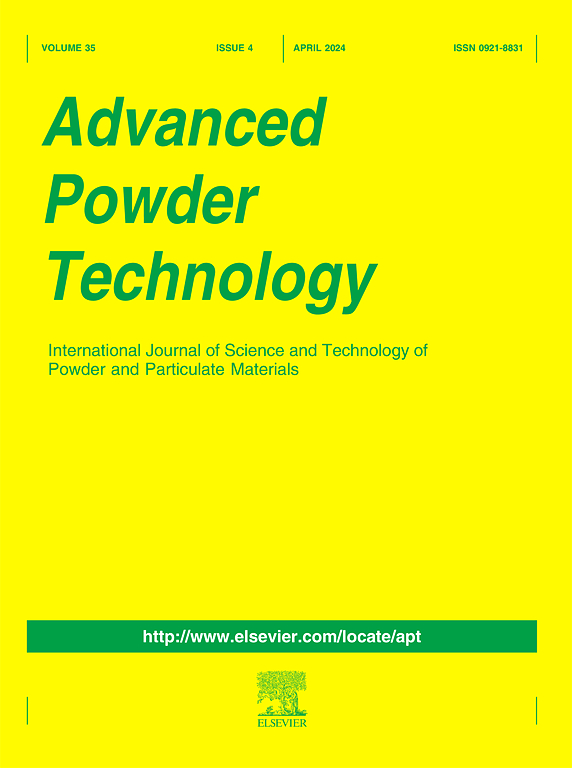粗煤泥三相流化床流态化特性试验研究
IF 4.2
2区 工程技术
Q2 ENGINEERING, CHEMICAL
引用次数: 0
摘要
气-液-固流化床对粗煤泥的分离效果较好,但其流体力学特性有待进一步研究。本研究研究了基于微压力传感器测量的实时压力波动信号的流动状态。通过压力波动曲线和概率密度函数对压力信号的频散进行了综合分析。根据压降-速度曲线的拐点,确定了流化的临界液体速度约为6*10−3 m/s。固定床表现出较高的标准差、偏度和峰度,表明不稳定性和不均匀性,而流化床表现出明显较低的时域值。通过频域分析可以实现流态分类的进一步细化,从而增强了流化床系统中颗粒和气泡动力学的表征。流化床总体压力波动能量低,在低气速下能量集中在低频区域(<10 Hz)。当气体速度超过1.5*10−3 m/s时,能量向更高频率(10 - 20 Hz)转移,反映出气泡湍流加剧。这一分析有助于进一步将流化床划分为气泡分散状态和颗粒湍流状态。流态化特性的研究阐明了流态化浮选的环境特征,为进一步的实验探索和三相系统矿物分离机理研究奠定了坚实的基础。本文章由计算机程序翻译,如有差异,请以英文原文为准。

Experimental investigation of coarse coal slime fluidization characteristics in three-phase fluidized beds
The gas-liquid-solid fluidized beds are highly effective for the separation of coarse coal slime, but their hydrodynamic behavior requires further clarification. This study investigates flow regimes based on real-time pressure fluctuation signals measured using micro-pressure sensors. A comprehensive analysis of pressure signal dispersion was conducted through pressure fluctuation curves and probability density functions. The critical liquid velocity for fluidization was identified at approximately 6*10−3 m/s, based on inflection points in pressure drop-velocity curves. Fixed beds exhibit elevated standard deviation, skewness, and kurtosis, signifying instability and non-uniformity, whereas fluidized beds display markedly lower time-domain values. Further refinement of flow regime classification can be achieved through frequency domain analysis, which provides enhanced characterization of particle and bubble dynamics within the fluidized bed system. Fluidized beds exhibit low overall pressure fluctuation energy, with power concentrated in low-frequency regions (<10 Hz) at low gas velocities. When the gas velocity exceeds 1.5*10−3 m/s, energy shifts toward higher frequencies (10–20 Hz), reflecting intensified bubble turbulence. This analysis facilitates the further delineation of fluidized bed into the bubble dispersion regime and particle turbulence regime. The investigation of fluidization characteristics clarifies the environmental features in fluidized flotation, thereby laying a solid foundation for further experimental exploration and mechanistic studies of mineral separation in three-phase systems.
求助全文
通过发布文献求助,成功后即可免费获取论文全文。
去求助
来源期刊

Advanced Powder Technology
工程技术-工程:化工
CiteScore
9.50
自引率
7.70%
发文量
424
审稿时长
55 days
期刊介绍:
The aim of Advanced Powder Technology is to meet the demand for an international journal that integrates all aspects of science and technology research on powder and particulate materials. The journal fulfills this purpose by publishing original research papers, rapid communications, reviews, and translated articles by prominent researchers worldwide.
The editorial work of Advanced Powder Technology, which was founded as the International Journal of the Society of Powder Technology, Japan, is now shared by distinguished board members, who operate in a unique framework designed to respond to the increasing global demand for articles on not only powder and particles, but also on various materials produced from them.
Advanced Powder Technology covers various areas, but a discussion of powder and particles is required in articles. Topics include: Production of powder and particulate materials in gases and liquids(nanoparticles, fine ceramics, pharmaceuticals, novel functional materials, etc.); Aerosol and colloidal processing; Powder and particle characterization; Dynamics and phenomena; Calculation and simulation (CFD, DEM, Monte Carlo method, population balance, etc.); Measurement and control of powder processes; Particle modification; Comminution; Powder handling and operations (storage, transport, granulation, separation, fluidization, etc.)
 求助内容:
求助内容: 应助结果提醒方式:
应助结果提醒方式:


